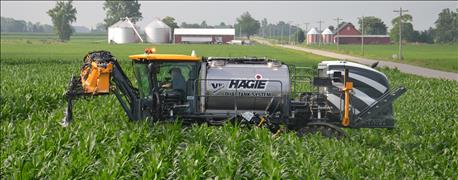
The person visible in the cab of this high-tech nitrogen applicator is Bob Nielsen. He is a Purdue University Extension corn specialist. But he wasn't driving this rig. The custom applicator was employed by Shelby County Co-op in Shelbyville. Nielsen was riding shotgun because, while this looks like an ordinary farm field, it’s also a giant field-scale replicated test for nitrogen application rates and timing.
The sprayer, set up for applying nutrients and other products even when corn is tall, contains two spray tanks, two application systems and two sets of nozzles. Application can be controlled by an onboard computer.

REV UP THE EXCITEMENT: Ken Simpson feels 20 years younger when he sees new technology in action as part of testing on his farm.
The applicator was ready to apply a later-season scheduled N application using another new technology: Y-Drops from 360 Yield Center. The Y-Drop concept is to place nitrogen on the surface near the base of each corn plant. One side of the Y places N near one row, and the other side of the Y puts N near the other row.
Watching all this happen, just outside of the picture, was Ken Simpson, the Morristown farmer who operates the farm. Only he wasn't standing on the ground looking at this rig. He was in his own rig, a Hagie sprayer equipped with a high-clearance bar that uses coulters to place liquid nitrogen under the soil surface.
He was applying the same rate as the other applicator. Thanks to the design Nielsen set up, the goal was not only to compare if adding nitrogen in a planned later-season application paid, but also to see if there was any difference due to application method.
Simpson was all smiles. Having farmed for more than four decades, he couldn’t believe two high-powered, techno rigs were in his cornfield at the same time, and doing replicated testing to boot. His only regret? He wishes he was 30 years younger so he could see exactly what new technology and replicated testing together could do for his farm in the future.
New software
Just how far has technology advanced? New software recently released by John Deere for its Operations Center gives combine operators even more capabilities than they had before. It’s not just about putting quality grain in the tank. Today, it’s about how to tie information about that quality grain to the site where it was produced. The Variety Locator, one of the new features in the software release, can automatically detect and document the crop variety that is being harvested!
The new software isn’t just for use in the combine. It also features new Tillage Maps and Speed Maps, which will help you figure out which variables of operation affect yield.
Joint dicamba agreement
Monsanto and DuPont recently announced a multiyear dicamba supply agreement for the U.S. and Canada. Both companies are looking ahead, hoping that EPA soon labels use of new dicamba-based herbicides on dicamba-resistant crops.
Monsanto will market Xtend herbicide for Xtend crops when the herbicide is approved for use. Under this agreement, DuPont will market FeXapan herbicide plus VaporGrip Technology.
The European Union just granted import approval to Roundup Ready 2 Xtend soybeans for food and feed use. China announced approval for import in February.
2 companies partner
WinField US and The Climate Corporation, a division of Monsanto Co., recently furthered their collaborative efforts by implementing a two-way, cross-navigation exchange of technology. It involves WinField’s decision ag solution, the R7 Tool, and Climate Corp.’s Climate FieldView platform.
This combined technology will be ready for the 2017 season. Both companies agree it’s one more step toward helping retailers help farmers make more informed, more profitable decisions.
About the Author(s)
You May Also Like




